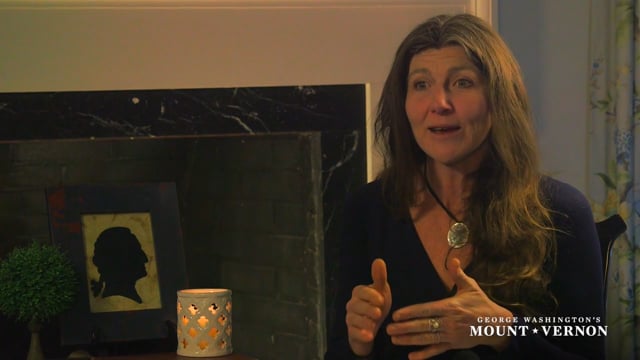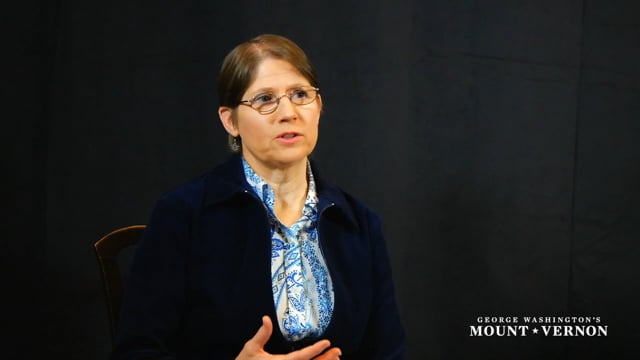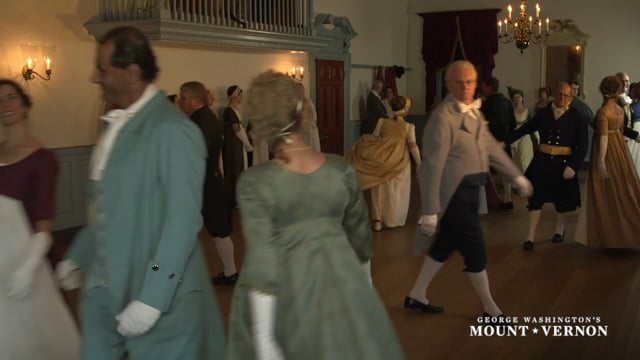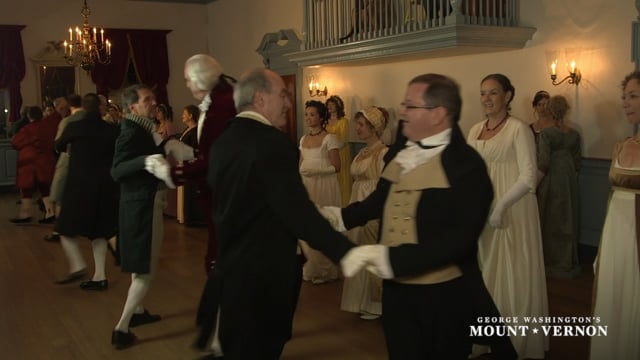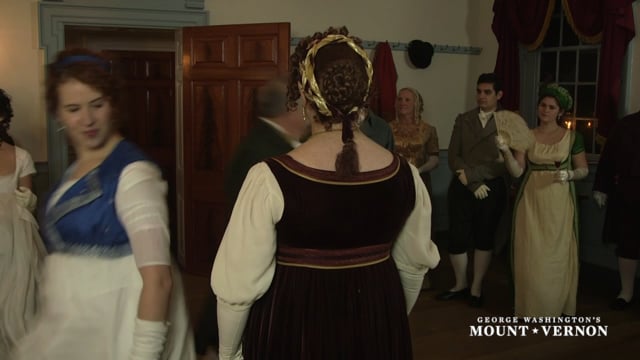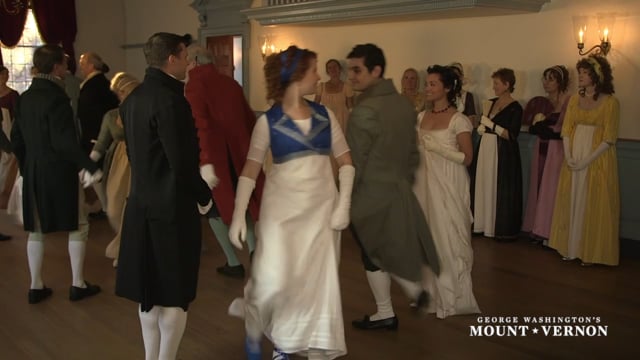Did Washington really love to dance? Emphatically, yes. Washington once described dancing as “so agreeable and innocent an amusement.” First-hand accounts say he was extremely good at it – and was always quite the center of attention.
MOUNT VERNON PRESENTS: “DANCING WITH GENERAL WASHINGTON”
Travel back in time to experience the genteel manners and graceful steps of an authentic 18th-century Virginia ball, set on location at Gadsby’s Tavern in Alexandria, Virginia, where George Washington attended public assemblies after his retirement from public office.
Dancing Styles of the 18th Century

Steps to Mrs. Savage’s Whim. Illustrated by Lisa Cassell.
| TYPE OF DANCE | DESCRIPTION |
| MINUET | A stylized two-person ceremonial dance with a complex foundational step. |
| COUNTRY DANCE |
Derived from English country dance. Couples form long lines where each has a turn leading the set. |
| COTILLION | Introduced to America around 1770. More challenging than country dance. |
| HORNPIPES and JIGS |
Danced by all social classes, these terms for usually free-form exhibition dances were used interchangeably. |
| REELS | Originally Scottish, these informal group dances had common basic movements that needed little instruction. |
| ALLEMANDES, RIGADOONS, and GAVOTTES |
Normally taught in dancing schools, this solo or duet dance was choreographed for display of skill in the ballroom. |
What Was Dancing Like in the 18th Century?
Learn from interpreters and historians from George Washington's Mount Vernon and the Colonial Williamsburg Foundation.
A Night at the Ball
While no written timeline of a Virginia ball exists today, they were often all-night affairs. A ball in the 18th century might have been organized like this:
7:00pm - Guest arrival with light refreshments and dancing
10:00pm – Seated supper
Midnight – Dancing resumes
5:00am – The last guests leave
Such a timeline would allow ample opportunity for dishing the latest gossip, discussing business and politics with neighbors, forming new acquaintances, and, of course – flirting.
Featured Dances from the Gadsby's Tavern Ball
Performed by the Gadsby's Tavern Dancers
"Play Not the Peacock": Manners in the Ballroom
The Washingtons attended balls after they were married, throughout the war, during the presidency in New York City and Philadelphia, and in Alexandria, Virginia near their Mount Vernon home.
From an early age, General Washington knew how to have a good time while maintaining the proper social conduct of the day. Personal deportment manuals abounded in the 18th century. As a boy, Washington copied the Rules of Civility of Decent Behavior in Company and Conversation, an edifying penmanship exercise which also undeniably shaped his public conduct. Below are two excerpts from the Rules of Civility that offer advice on proper comportment:
1: “Every action done in Company, ought to be with Some Sign of Respect, to those that are Present.”
54: “Play not the Peacock, looking everywhere about you, to See if you be well Deck’t, if your shoes fit well, if your Stockings sit neatly, and Cloths handsomely.”
In addition to instructive publications, most youngsters in the Virginia gentry would have been taught how to dance properly by a Dance Master. The Dance Master would have provided instruction similar to this passage from Francis Nevelon’s, The Rudiments of Genteel Behavior, 1737, with specific directions for young ladies:
“Keep the Head not quite upright, but incline it a little with graceful Motion and all imaginable Ease; let the Eyes appear lively and modest, and the Face express neither Mirth nor Gravity but the Medium, which will form an amiable Mein and always be agreeable; the Neck to the Shoulders, and from them to the Elbows and Wrists are truly proportion’d, and a genteel Attitude plainly shewn in this Figure; each Forefinger and Thumb must hold the Petticoat, and the other fingers must be a little separated; the Body should have a little Swing in its Motion, just to avoid the appearance of Stiffness, and let the Feet appear well turn’d and without any Affectation, as in this Figure which shows certainly the proper Behavior in Dancing, it appearing from Head to Foot modest, light and easy.”
18th -century music sheet, engraved by George Bickham. London, England. Steel engraving on paper. The Gabrielle Enthoven Collection, The Victoria & Albert Museum, London.
Dancing During the Revolutionary War
Despite the horrors and atrocities of war, balls continued to be held in the colonies during the American Revolution. Below is an excerpt from Dr. James Thacher, a surgeon in the Revolutionary War who served in the Massachusetts 16th Regiment:
“The anniversary of our alliance with France was celebrated in proper style a few days since near head-quarters, at Pluckemin…In the evening a very beautiful set of fire-works was exhibited, and the celebration was concluded by a splendid ball, opened by his Excellency General Washington, having for his partner the lady of General Knox” [1] - Dr. James Thacher, Pluckemin, New Jersey, February 4, 1779
The Gossip: What Was Washington Like on the Dance Floor?
“His Excellency (George Washington) and Mrs. Greene (wife of Nathaniel Greene) danced upwards of three hours without once sitting down.” [2] – General Nathanael Greene to Colonel Jeremiah Wadsworth, Middle Brook, New Jersey, March 19, 1779.
“His Excellency General Washington was unusually cheerful. He attended the ball in the evening, and with a dignified and graceful air, having Mrs. Knox for his partner, carried down a dance of twenty couples in the arbor on the green grass." [3] – General Nathanael Greene to Joseph Reed, Morristown, New Jersey, Tuesday February 29, 1780.
“The General danced every set, that all the ladies might have the pleasure of dancing with him, or as it has since been handsomely expressed, get a touch of him.”[4] – James Tilton to Gunning Bedford Jr., Annapolis, Maryland, December 25, 1783.
“He (George Washington) attended the ball of the 22nd of February; opened it by dancing a minuet with some lady, and then danced cotillions and country dances; was very gallant, and always attached himself, by his attentions, to some one or more of the most beautiful and attractive ladies at the balls.” – Judge Francis T. Brooke (1784).
“We were not long seated when General Washington entered, and bowed to the ladies as he passed round the room. ‘He comes, he comes, the hero comes!’ I involuntarily but softly exclaimed. When he bowed to me, I could scarcely resist the impulse of my heart that almost burst through my bosom, to meet him.” – Miss Charlotte Chambers to her mother, Mrs. James Chambers Wednesday February 25, 1795.
Jean Leon Gerome Ferris, "The Victory Ball, 1781", ca. 1929. This 20th-century depiction of Washington takes place after the Battle of Yorktown. (C) Virginia Museum of History & Culture (1996.49.5) Purchased with funds provided by Lora M. Robins
Costume in Detail
Take a closer look at the costumes, hair, and accessories featured in "Dancing with General Washington"
Huzzah! Mount Vernon Would Like to Thank:
The Colonial Williamsburg Foundation, Cathy Hellier and Marcia Wright; The Victoria & Albert Museum, London; Lary and Erica Hoffman and The Galaxy Hut in Arlington, Virginia; Gadsby's Tavern Museum in Alexandria, Virginia, Gretchen Bulova and Corky Palmer; The Gadsby's Tavern Dancers, American Duchess and Lauren Stowell, Dames a la Mode and Taylor Shelby, Jenny-Rose White and Bobby Pins and Blush, and Production Assistant A. Boyce.
Footnotes
[1] George Washington to the Alexandria General Assemblies Managers, Mount Vernon, November 12, 1799.
[2] James Thacher, February 4, 1779, Military Journal of the American Revolution, From the commencement to the Disbanding of the American Army; Comprising a detailed account of the principal events and Battles of the Revolution, With Their Exact Dates, And a Biographical Sketch of the most Prominent Generals (Hartford, Connecticut: Published by Subscription Only by Hurlburt, Williams & Company, American Subscription Publishing House, 1862), 159.
[3] General Nathanael Greene to Colonel Jeremiah Wadsworth, March 19, 1779, in The Papers of General Nathanael Greene, 9 volumes, edited by Richard K. Showman and Dennis M. Conrad (Chapel Hill: Published for the Rhode Island Historical Society by the University of North Carolina Press, 1976-1997), 3:254.
[4] General Nathanael Greene to Joseph Reed, Morristown, New Jersey, Tuesday February 29, 1780.
[5] James Tilton to Gunning Bedford, Jr., December 25, 1783, in the Founders on the Founders, 488-489.
[6] James Tilton to Gunning Bedford, Jr., December 25, 1783, in the Founders on the Founders, 488-489.
Additional Resources
Giordano, Ralph G. Social Dancing in America: A History and Reference. Westport, CT: Greenwood, 2007. Print.
Hendrickson, Charles Cyril., and Frances Cibel. Hendrickson. Early American Dance and Music: John Griffiths, Dancing Master: 29 Country Dances, 1788. No. 1 in the Series. Sandy Hook, CT: Hendrickson Group, 1989. Print.
Hendrickson, Charles Cyril., and Kate Van Winkle. Keller. Social Dances from the American Revolution. Sandy Hook, CT: Hendrickson Group, 1992. Print.
Keller, Kate Van Winkle, and Charles Cyril Hendrickson. George Washington: A Biography in Social Dance. Sandy Hook, CT: Hendrickson Group, 1998. Print.
Keller, Kate Van Winkle., and Ralph Sweet. A Choice Selection of American Country Dances of the Revolutionary Era, 1775-1795. New York: Country Dance and Song Society of America, 1976. Print.
Millar, John Fitzhugh. Country Dances of Colonial America. Williamsburg, VA: Thirteen Colonies, 1990. Print.
Nivelon, François. The Rudiments of Genteel Behavior, 1737. London: Paul Holberton, 2003. Print.
